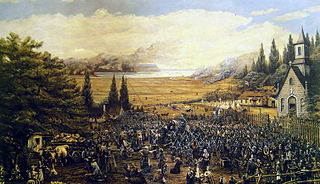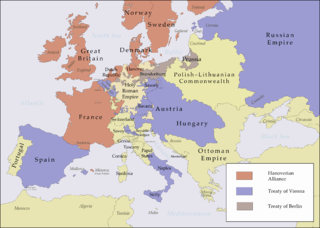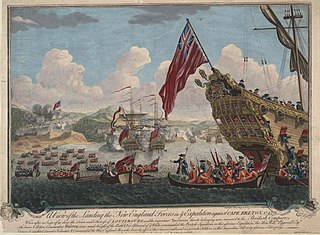Contents
This article needs additional citations for verification .(February 2024) |
| |||
|---|---|---|---|
| Buildings and structures +... |
This article needs additional citations for verification .(February 2024) |
| |||
|---|---|---|---|
| Buildings and structures +... |


Cape Breton Island is a rugged and irregularly shaped island on the Atlantic coast of North America and part of the province of Nova Scotia, Canada.

1755 (MDCCLV) was a common year starting on Wednesday of the Gregorian calendar and a common year starting on Sunday of the Julian calendar, the 1755th year of the Common Era (CE) and Anno Domini (AD) designations, the 755th year of the 2nd millennium, the 55th year of the 18th century, and the 6th year of the 1750s decade. As of the start of 1755, the Gregorian calendar was 11 days ahead of the Julian calendar, which remained in localized use until 1923.

1745 (MDCCXLV) was a common year starting on Friday of the Gregorian calendar and a common year starting on Tuesday of the Julian calendar, the 1745th year of the Common Era (CE) and Anno Domini (AD) designations, the 745th year of the 2nd millennium, the 45th year of the 18th century, and the 6th year of the 1740s decade. As of the start of 1745, the Gregorian calendar was 11 days ahead of the Julian calendar, which remained in localized use until 1923.

1725 (MDCCXXV) was a common year starting on Monday of the Gregorian calendar and a common year starting on Friday of the Julian calendar, the 1725th year of the Common Era (CE) and Anno Domini (AD) designations, the 725th year of the 2nd millennium, the 25th year of the 18th century, and the 6th year of the 1720s decade. As of the start of 1725, the Gregorian calendar was 11 days ahead of the Julian calendar, which remained in localized use until 1923.

King George's War (1744–1748) is the name given to the military operations in North America that formed part of the War of the Austrian Succession (1740–1748). It was the third of the four French and Indian Wars. It took place primarily in the British provinces of New York, Massachusetts Bay, New Hampshire, and Nova Scotia. Its most significant action was an expedition organized by Massachusetts Governor William Shirley that besieged and ultimately captured the French fortress of Louisbourg, on Cape Breton Island in Nova Scotia, in 1745. In French, it is known as the Troisième Guerre Intercoloniale or Third Intercolonial War.

The Fortress of Louisbourg is a tourist attraction as a National Historic Site and the location of a one-quarter partial reconstruction of an 18th-century French fortress at Louisbourg on Cape Breton Island, Nova Scotia. Its two sieges, especially that of 1758, were turning points in the Anglo-French struggle for what today is Canada.

Louisbourg is an unincorporated community and former town in Cape Breton Regional Municipality, Nova Scotia.
Tatamagouche is a village in Colchester County, Nova Scotia, Canada.

Pictou is a town in Pictou County, in the Canadian province of Nova Scotia. Located on the north shore of Pictou Harbour, the town is approximately 10 km north of the larger town of New Glasgow.

Events from the year 1745 in Canada.

Events from the year 1758 in Canada.
The year 1822 in architecture involved some significant events.

The siege of Louisbourg took place in 1745 when a New England colonial force aided by a British fleet captured Louisbourg, the capital of the French province of Île-Royale during the War of the Austrian Succession, known as King George's War in the British colonies.

Louisbourg Lighthouse is an active Canadian lighthouse in Louisbourg, Nova Scotia. The current tower is the fourth in a series of lighthouses that have been built on the site, the earliest was the first lighthouse in Canada.

The Raid on Canso was an attack by French forces from Louisbourg on the British outpost Fort William Augustus at Canso, Nova Scotia shortly after war declarations opened King George's War. The French raid was intended to boost morale, secure Louisbourg's supply lines with the surrounding Acadian settlements, and deprive Britain of a base from which to attack Louisbourg. There were 50 English families in the settlement. While the settlement was utterly destroyed, the objective failed, since the British launched an attack on Louisbourg in 1745, using Canso as a staging area.

Englishtown is an unincorporated area in the Municipality of the County of Victoria, Nova Scotia, Canada. It is the site of the Englishtown Ferry cable ferry that carries Nova Scotia Route 312 across St. Anns Harbour.
The history of lighthouses in Canada dates to 1734.
This is a bibliography of major works on Nova Scotia.
The French ship Chameau or Le Chameau (Camel) was a wooden sailing ship of the French Navy, built in 1717. She was used to transport passengers and supplies to New France, making several trips. Nearing the end of her last voyage, a storm blew her onto some rocks on August 27, 1725. She sank, with the loss of all aboard; estimates range as high as 316 dead. In 1965, Alex Storm and his associates located the wreckage near Chameau Rock, and recovered a treasure of gold and silver pieces.

The siege of Annapolis Royal in 1745 involved the third of four attempts by the French, along with their Acadian and native allies, to regain the capital of Nova Scotia/Acadia, Annapolis Royal, during King George's War. During the siege William Pote was taken prisoner and wrote one of the rare captivity narratives that exist from Nova Scotia and Acadia.